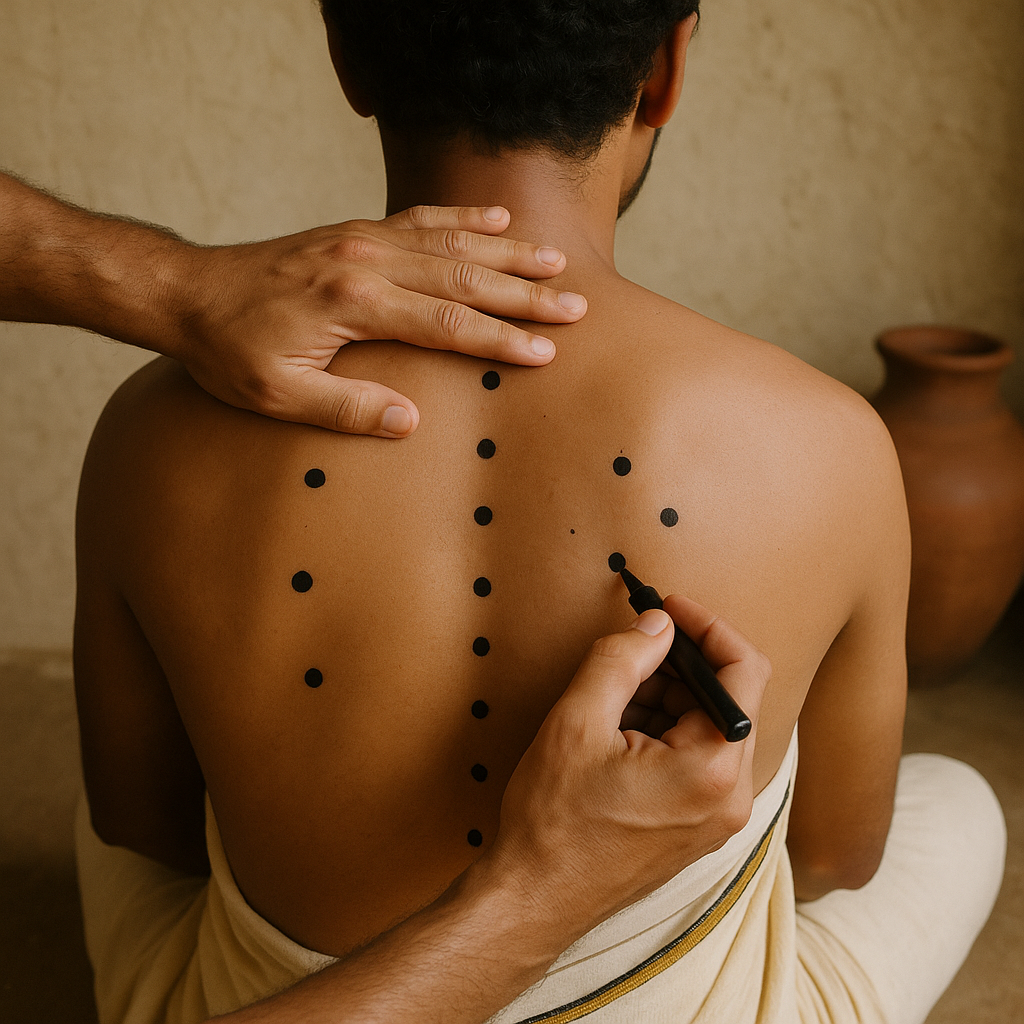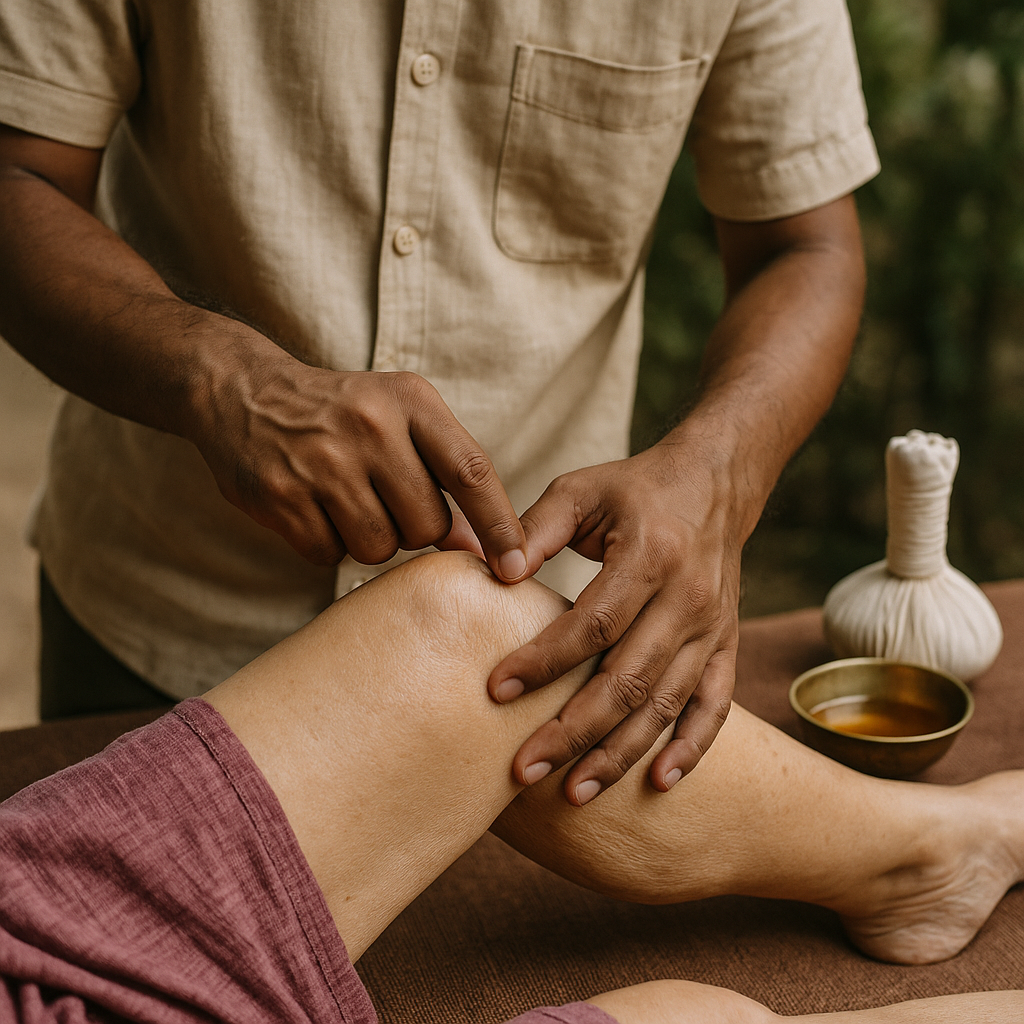आयुर्वेदिक डॉक्टर से प्रश्न पूछें और निःशुल्क या भुगतान मोड में अपनी चिंता की समस्या पर ऑनलाइन परामर्श प्राप्त करें। 2,000 से अधिक अनुभवी डॉक्टर हमारी साइट पर काम करते हैं और आपके प्रश्नों का इंतजार करते हैं और उपयोगकर्ताओं को उनकी स्वास्थ्य समस्याओं को हल करने में प्रतिदिन मदद करते हैं।
अभी हमारे स्टोर में खरीदें
What Is Marma Chikitsa in Ayurveda: Points, Healing, and Benefits

In a world brimming with modern medical interventions, many of us are quietly turning back to ancient wisdom for gentler, more holistic healing methods. One such gem is Marma Chikitsa. So, what is Marma Chikitsa? And why is it getting so much buzz lately in wellness spaces?
Marma Chikitsa in Ayurveda is an age-old technique rooted deeply in the Vedic sciences, focusing on energy points across the body to promote balance, health, and rejuvenation. From back pain to emotional stress, Marma therapy is believed to help in ways that are both subtle and deeply profound. This article dives into Ayurveda Marma Chikitsa, exploring its meaning, how it works, key points, and real-world benefits. Whether you're curious about alternative therapies or just looking for natural ways to ease discomfort, you might just find this fascinating. Let’s dive in!
Marma Chikitsa Meaning and Its Roots in Vedic Healing
So, let’s start at the beginning. What is Marma Chikitsa, really?
In simple Marma Chikitsa in English, it translates to “energy point treatment” or “vital spot therapy.” The word “Marma” refers to hidden, vital energy points in the body, while “Chikitsa” means treatment or therapy. These points are where muscles, veins, ligaments, bones, and joints intersect — forming potent healing spots when stimulated correctly.
This concept isn’t new. In fact, it’s thousands of years old. Vedic Marma Chikitsa dates back to ancient Sanskrit texts like the Sushruta Samhita. Originally used on warriors to both harm and heal, this therapy evolved into a sophisticated healing system — one that doesn't just treat the body, but touches the mind and spirit too.
The system is deeply intertwined with Ayurveda, India’s traditional medicine system. Practitioners believe that blocked or unbalanced prana (life force energy) leads to illness, and by manipulating marma points, one can restore that flow. Kind of like acupuncture, but without needles and a very different philosophical base.

How Marma Chikitsa Works: Energy Points and Techniques
Marma Chikitsa is not just random pressure-point pressing — it’s precise, intentional, and deeply intuitive. Each point has a function, a name, and a purpose within the body's energetic and anatomical map.
Important Marma Points in the Body
There are 107 major marma points in the human body (some count the mind as the 108th). These are categorized based on their locations — like head, chest, arms, and legs — and their elemental properties (earth, water, fire, air, ether). Some key examples include:
-
Sthapani Marma (forehead) – helps calm the mind
-
Hridaya Marma (heart region) – vital for circulation and emotions
-
Kurcha Marma (wrist/ankle area) – supports joint mobility and nerve function
Interestingly, many of these points overlap with the body's lymph nodes, nerve junctions, and muscle insertions — modern science may be just catching up!
Vedic Approach to Marma Activation
Marma Chikitsa in Ayurveda involves more than physical touch. Therapists may use gentle pressure, essential oils, warm herbal pastes, and even focused intention to stimulate the points.
Sometimes, chanting or breathing techniques accompany the therapy — all aiming to balance doshas (Vata, Pitta, Kapha) and encourage the flow of prana. It’s not uncommon for people to feel sleepy, emotional, or extremely relaxed after a session. (Or all three. I once dozed off mid-treatment. Whoops.)
The practitioner's hands act as healing tools, subtly awakening stuck energies. It’s precise — too much pressure can do more harm than good, especially on vulnerable points.
Benefits of Marma Chikitsa for Body and Mind
This isn’t just woo-woo stuff (although some skeptics might think so at first glance). The benefits of Marma Chikitsa are increasingly appreciated in integrative health circles:
-
✅ Pain Relief – Especially Marma Chikitsa for back pain and Marma Chikitsa for knee pain, where chronic tension or inflammation responds well to localized point activation.
-
✅ Improved Circulation – Stimulating energy points boosts blood flow and lymphatic drainage.
-
✅ Mental Clarity & Emotional Balance – Many find relief from anxiety, stress, and even depressive symptoms.
-
✅ Boosts Immunity – By strengthening internal systems and removing energetic blockages, the body can better defend itself.
-
✅ Detoxification – Helps eliminate toxins (ama) from the tissues.
In a study published by Ayurvedic journals (yes, they exist), patients undergoing regular Marma therapy showed notable improvements in mobility and mood within just a few weeks. Anecdotal? Maybe. But compelling? Definitely.
And one more thing... unlike some intense treatments, Marma is non-invasive. It can be performed seated or lying down, fully clothed, and adapted for nearly all age groups. Well, unless you're in the middle of a cold or recovering from surgery — then it’s best to wait.

When and How Marma Therapy Is Applied in Ayurveda
Unlike some treatments you’d just drop in for when something hurts, Marma Chikitsa in Ayurveda is often used both preventively and curatively. That means — yup — you can benefit from it even if nothing’s “wrong.”
So when is it actually applied?
Let’s say you’re dealing with chronic joint pain, like knee stiffness that doesn’t quit. Or that nagging back pain from too much screen time. In these cases, Marma Chikitsa for knee pain and Marma Chikitsa for back pain can be super effective. By targeting specific marma points, the therapy helps reduce inflammation, increase circulation, and realign energy flow to support healing.
But it’s not just for pain relief.
Marma therapy is also used for:
-
Post-illness recovery (like after a viral infection or injury)
-
Sleep disorders
-
Fatigue and burnout (that “running on empty” feeling)
-
Hormonal imbalances
-
And even emotional trauma (yes, the body holds memories too)
How Sessions Typically Work
A typical session starts with a quick consultation — an Ayurvedic practitioner might assess your dosha type, ask about your lifestyle, digestion, sleep patterns, and overall vibe (that’s not the technical term, but you get it).
Then, you'll lie down in a quiet room, usually dimly lit, often with some soft mantra music playing in the background. The therapist will gently stimulate a series of marma chikitsa points using fingers, sometimes tools or herbal oils, depending on your imbalance.
Each session can last between 30 to 60 minutes. There may be warmth, tingling, or a slight emotional release. Some folks cry. Others just nap. There’s no “right” response, which is kind of beautiful, honestly.
The number of sessions needed varies. Some people feel relief after just one. Others may need a few rounds to feel the deeper shifts. But unlike popping a pill, this form of healing requires a bit of patience — and an open mind.
Oh! And don’t eat a heavy meal right before. You’ll regret it, trust me.
Conclusion
So, what is Marma Chikitsa? It’s more than just an ancient bodywork technique — it’s a full-spectrum, energy-aligned therapy that taps into the intelligence of the body and the wisdom of Ayurveda. Whether you're new to holistic healing or already on your journey, exploring Ayurveda Marma Chikitsa might just change how you think about health and vitality.
It’s not magic — though it might feel like it.
By connecting to these powerful marma points, people are finding relief from physical pain, emotional clutter, and energetic fatigue in ways modern medicine often can’t quite reach.
Feeling curious now? Maybe even inspired?
FAQs
What is the cost of marma therapy?
Costs vary depending on where you live and who you’re seeing. In India, sessions might start around ₹500–1500. In the U.S. or Europe, they can range from $40 to $120 per session. Some practitioners offer packages too.
What are the three types of Chikitsa?
In Ayurveda, the three main types of Chikitsa are:
-
Daivavyapashraya Chikitsa – spiritual or divine therapy
-
Yuktivyapashraya Chikitsa – logical, medicinal treatment (like herbs, diet)
-
Sattvavajaya Chikitsa – psychological or mind-control therapy
Marma Chikitsa falls under Yuktivyapashraya, but also overlaps with the other two — which is why it’s so holistic.
What are the side effects of marma therapy?
Usually, there are no harsh side effects if done correctly. Some people feel tired, emotional, or lightheaded afterward — it’s the body adjusting. But if the wrong point is pressed too hard or by someone untrained, it can cause pain or worsen symptoms. Always go to a skilled practitioner!
Ready to experience this ancient healing art yourself?
🌿 Book a Marma session near you or talk to a qualified Ayurvedic practitioner to see if it’s right for you.
And hey, if you found this helpful — share it with a friend who’s into wellness. Or that coworker who keeps complaining about back pain. They’ll thank you later.
यह लेख वर्तमान योग्य विशेषज्ञों द्वारा जाँचा गया है Dr Sujal Patil और इसे साइट के उपयोगकर्ताओं के लिए सूचना का एक विश्वसनीय स्रोत माना जा सकता है।

